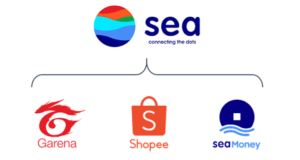
The Birth of a Titan: Inside Sea Limited
In the heart of Southeast Asia, a tech titan emerged from humble beginnings. In 2009, Forrest Li and Gang Ye founded Garena, a platform offering online games like League of Legends. This small seed soon blossomed into Sea Limited, a digital empire encompassing e-commerce, gaming, and fintech. Shopee, Sea’s e-commerce arm, conquered Southeast Asia’s burgeoning internet market with its user-friendly interface and competitive pricing. Free Fire, a mobile battle royale game, ignited a global phenomenon, captivating millions of players with its fast-paced action and freemium model. SeaMoney, the company’s financial services arm, seamlessly integrated with its existing platforms, offering users a convenient one-stop shop for digital payments and financial solutions.
Sea’s growth was nothing short of phenomenal. From its early days as a gaming company, it expanded rapidly, fueled by aggressive expansion, strategic partnerships, and an unwavering focus on innovation. Shopee’s dominance in e-commerce made it a household name across the region, while Free Fire’s popularity transcended borders, generating millions in revenue and boosting Sea’s global recognition. SeaMoney, with its intuitive platform and accessible financial tools, empowered millions across Southeast Asia to participate in the digital economy. By 2021, Sea had ascended to become the most valuable company in Southeast Asia, a testament to its visionary leadership and its ability to adapt and capitalize on the region’s rapid digital transformation.
However, the tech giant’s meteoric rise was not without its challenges. Economic headwinds, intense competition, and regulatory hurdles threatened to slow its momentum. Yet, Sea’s story remains one of resilience and adaptability. Its journey, from a small gaming platform to a diversified digital powerhouse, serves as an inspiration for entrepreneurs and a valuable case study for navigating the ever-evolving landscape of the tech world.
Rise to Prominence: Sea Limited, a Tech Titan Forged in Southeast Asia
In 2009, amidst the burgeoning internet landscape of Southeast Asia, a fledgling venture named Garena took its first steps. Founded by Forrest Li and Gang Ye, with online games like League of Legends as their initial offering, Garena laid the groundwork for what would become the region’s digital behemoth: Sea Limited.
From its video game roots, Sea’s ascent was nothing short of meteoric. In 2015, it launched Shopee, an e-commerce platform tailored for the mobile-first Southeast Asian market. With its intuitive interface, competitive pricing, and strategic integration with social media, Shopee’s growth was explosive. By 2021, it had captured a dominant share of the regional e-commerce market, boasting over 427 million active users and processing over US$85 billion in gross merchandise value (GMV).
But Sea’s ambitions extended beyond e-commerce. In 2017, it launched Free Fire, a mobile battle royale game, that quickly ignited a global phenomenon. With its fast-paced action, dynamic character customization, and freemium model, Free Fire racked up over 1 billion downloads and generated over US$10 billion in lifetime revenue as of 2023. This runaway success catapulted Sea onto the global gaming stage, securing partnerships with industry giants like Tencent and solidifying its position as a major player in the mobile gaming arena.
Rounding out its digital ecosystem, Sea launched SeaMoney in 2014, offering a suite of financial services seamlessly integrated with its existing platforms. From digital wallets and mobile payments to online insurance and credit services, SeaMoney empowered millions of Southeast Asians to participate in the digital economy, bridging the gap between traditional finance and the world of mobile transactions. By 2022, SeaMoney had secured over 40 million active users across the region, processing over US$12 billion in transactions.
Sea’s rise to prominence wasn’t merely about building individual platforms; it was about understanding and shaping the unique digital landscape of Southeast Asia. The company’s success can be attributed to several key factors:
- Focus on mobile-first solutions: Recognizing the mobile-centric nature of the region, Sea prioritized mobile-friendly platforms like Shopee and Free Fire, ensuring accessibility and ease of use for its target audience.
- Deep understanding of local markets: Sea meticulously tailored its offerings to the cultural and behavioral nuances of each Southeast Asian nation, ensuring relevance and resonating with local users.
- Strategic partnerships: Collaborations with established players like Tencent and Alibaba helped Sea gain access to resources, expertise, and user bases, accelerating its growth trajectory.
- Relentless innovation: Always adapting to changing market trends and user preferences, Sea continuously introduced new features and services, keeping its platforms fresh and engaging.
In just over a decade, Sea transformed from a humble gaming startup into a diversified digital powerhouse, dominating the e-commerce, gaming, and fintech landscapes of Southeast Asia. Its journey serves as a testament to the potential of the region’s digital market and an inspiration for entrepreneurs worldwide. As Sea continues to innovate and expand, its impact on the global digital landscape is sure to be felt for years to come.
Sea Limited’s Descent: A Perfect Storm of Internal and External Pressures
In 2023, Sea Limited, once the undisputed tech titan of Southeast Asia, witnessed a breathtaking downfall. Its market capitalization, hovering around $200 billion in 2021, plummeted by over 80%, leaving investors bewildered and the industry at large scrambling to understand what went wrong. The fall, however, wasn’t a single misstep but a culmination of several internal and external pressures, each chipping away at the company’s once-unassailable foundation.
1. Macroeconomic Headwinds: The global economic downturn of 2023 was a major blow to Sea’s core markets. Southeast Asia, known for its vibrant consumer spending, suddenly saw wallets tightening. Shopee, the e-commerce behemoth, saw its Gross Merchandise Value (GMV) growth slowing from 85% in 2021 to a mere 28% in 2023, a chilling sign of changing consumer behavior.
2. Free Fire’s Fading Glow: Free Fire, the mobile game that propelled Sea to global fame, experienced a sharp decline in player engagement and monetization. User downloads dropped from 240 million in 2021 to 150 million in 2023, with revenue dipping proportionally. This overdependence on a single, aging game proved disastrous as competition from newer titles like PUBG Mobile and Fortnite intensified.
3. E-commerce Erosion: While Shopee still reigns in Southeast Asia, its dominance faced increasing challenges. Rivals like Lazada and Tokopedia chipped away at market share, while logistical disruptions and regulatory hurdles hampered expansion. Furthermore, concerns about counterfeit goods and consumer protection issues on Shopee eroded user trust, leading to further defections.
4. Overambitious Expansion: Blinded by its early success, Sea embarked on ambitious global expansion plans, venturing into markets like India and Latin America. However, these endeavors proved costly and ineffective. Cultural miscalculations, underestimation of local competition, and inadequate support infrastructure led to disappointing results, draining resources from Sea’s core markets.
5. Internal Discord: Whispers of internal turmoil and leadership conflicts within Sea began to surface. Reports of resignations from key executives, clashes between departments, and a lack of clear strategic direction further rattled investor confidence, exacerbating the company’s existing woes.
6. Unsustainable Burning: Sea’s rapid growth was fueled by aggressive marketing and promotional campaigns, often at the expense of long-term profitability. This unsustainable model, reliant on burning cash to acquire users, became untenable as the economic downturn tightened the purse strings.
7. Geopolitical Turbulence: The ongoing trade war between the US and China, coupled with the war in Ukraine, further disrupted global supply chains and impacted Sea’s operations and profitability. Rising shipping costs and production delays compounded the existing challenges, adding fuel to the fire.
Sea Limited’s collapse serves as a stark reminder that even the most formidable tech giants are not immune to the vicissitudes of the market. This once-shining example of Southeast Asian ingenuity succumbed to a combination of internal missteps and external pressures. While the company’s future remains uncertain, the lessons learned from its downfall offer valuable insights for navigating the ever-evolving landscape of the global tech industry.
The Ripples of a Titan’s Fall: Sea Limited’s Collapse and its Impact
Sea Limited’s downfall in 2023 reverberated through the tech world and beyond, leaving a trail of consequences that continue to be felt today. Its once-unshakeable dominance in Southeast Asia crumbled, sending shockwaves through the region’s digital landscape and beyond. Let’s delve into the wide-ranging impact of Sea’s collapse, exploring the financial fallout, job losses, and shaken investor confidence.
Financial Fallout:
- Market Meltdown: Sea’s stock price plummeted from a high of $373.58 in 2021 to a mere $33.74 by October 2023, marking a staggering 89% decline in just two years. This translates to a staggering $170 billion wiped off the company’s market capitalization, leaving investors reeling and questioning the future of Southeast Asian tech.
- Eroded Revenue: Shopee, once a growth engine, saw its GMV growth drop from 85% in 2021 to 28% in 2023. This slowdown, coupled with declining revenue from Free Fire and SeaMoney, resulted in a significant financial squeeze for the company.
- Debt Burden: In an attempt to fuel its expansion, Sea had accumulated significant debt. However, with the revenue slowdown, servicing this debt became increasingly difficult, further straining the company’s financial position.
Job Losses:
- Mass Layoffs: As Sea grappled with its financial woes, it was forced to make tough decisions. Over 7,000 employees, across various departments and regions, were laid off in 2023, casting a shadow over the company’s once-vibrant culture.
- Talent Drain: The layoffs, coupled with the overall uncertainty surrounding Sea’s future, led to a talent drain. Key executives and skilled employees departed for greener pastures, further weakening the company’s ability to navigate the challenges it faced.
- Impact on Livelihoods: The job losses rippled through the communities where Sea operated, impacting families and livelihoods. The sudden loss of income, coupled with the economic downturn, added to the overall sense of uncertainty and hardship.
Shaken Investor Confidence:
- Southeast Asian Tech Jitters: Sea’s collapse cast a long shadow over the entire Southeast Asian tech sector. Investors, once eager to pour money into the region’s promising startups, became cautious, fearing similar downfalls. This decline in investor confidence hampered funding opportunities for other tech companies, hindering the region’s overall growth potential.
- Global Tech Concerns: The Sea saga also raised concerns about the sustainability of other high-growth tech companies, particularly those reliant on aggressive marketing and promotional campaigns. Investors became more discerning, demanding greater focus on profitability and long-term resilience.
The impact of Sea Limited’s collapse is far-reaching and complex. It has left a mark on the financial landscape, the lives of its employees, and the broader tech ecosystem in Southeast Asia and beyond. While the company’s future remains uncertain, the lessons learned from its downfall serve as a cautionary tale for other tech giants and offer valuable insights into the ever-evolving world of tech.
It’s important to note that the impact of Sea’s collapse is still unfolding, and the full extent of the consequences may not be known for some time. However, by examining the immediate effects, we can gain valuable insights into the vulnerabilities of even the most successful tech companies and the importance of building sustainable, resilient businesses.
Disclaimer: This article is for informational purposes only and should not be considered as financial advice. The information contained herein is based on publicly available data and may not be complete or accurate. The author is not a financial advisor and makes no representations or warranties regarding the accuracy or completeness of the information provided. Any investment decisions should be made after careful consideration and independent research, with the assistance of a qualified financial advisor if necessary. Furthermore, the opinions expressed in this article are solely those of the author and do not necessarily reflect the views of any other individual or organization.









